In Surviving the Aftermath you take control of a tiny colony of apocalypse survivors and must guide them through their own personal post-extinction-level-event timeline. Gathering resources, exploring the ruined remnants of society and fighting off crisis after crisis are all on the cards for this plucky group.
Publisher Paradox Interactive had a hit on their hands a few years ago with Surviving Mars, a simulation of trying to establish a colony in a hostile environment while fighting off disasters and trying to become self-sufficient. That game was from Haemimont Games — the developer of Tropico. Now Iceflake Studios have entered the fray with Surviving the Aftermath, a simulation of… trying to establish a… colony in a hostile environment while fighting off… you know what, I think you know where I’m going with this.
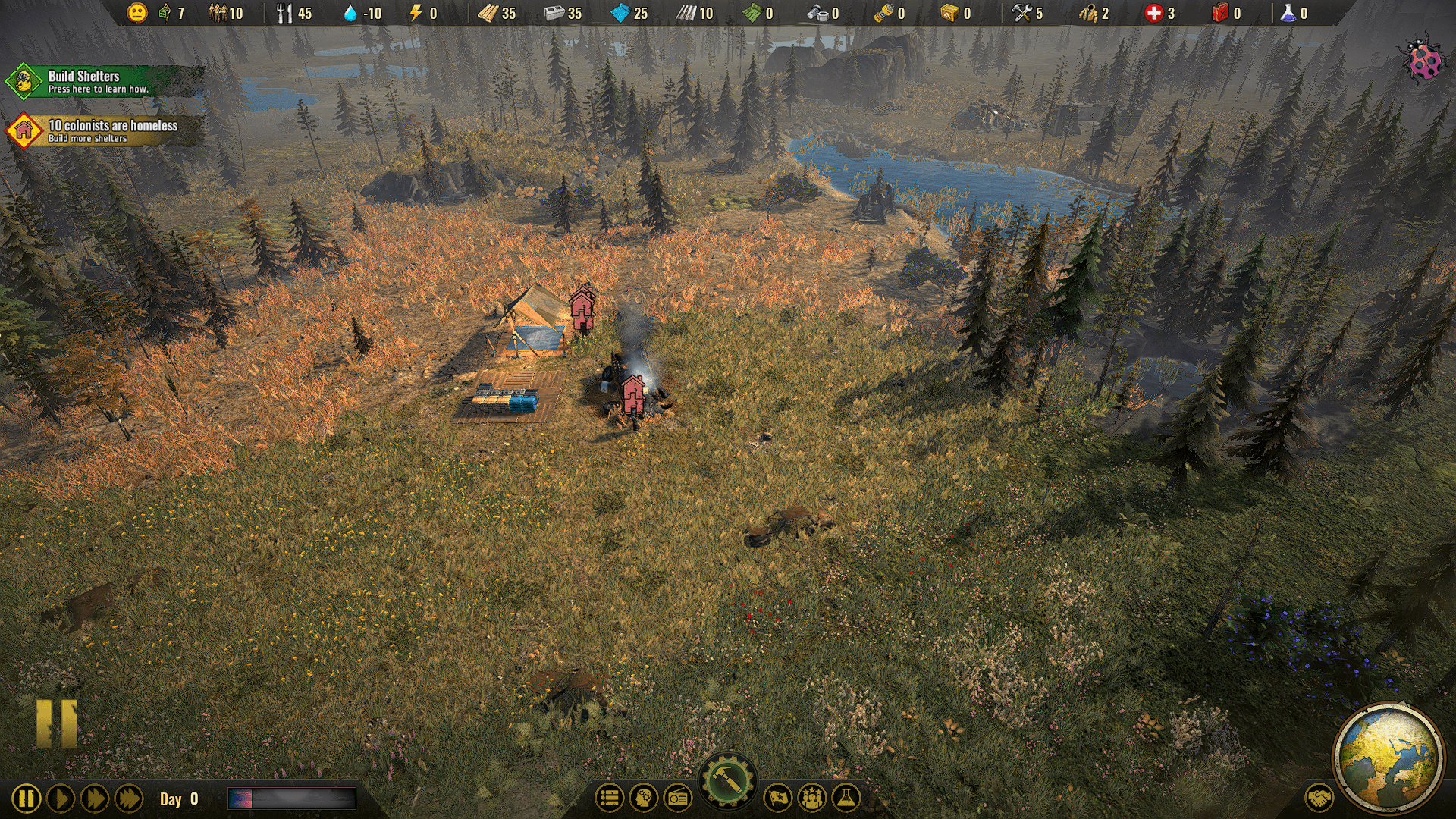
The PC gaming scene is not short of survival simulators; from the aforementioned Surviving Mars to Dead State and Frostpunk, all via the daddy of them all, Rimworld. It’s a crowded scene to try and break into but Surviving the Aftermath aims for a niche with its setting: following a global nuclear catastrophe. Imagine trying to build a colony in the wake of the nuclear war of the Fallout universe but minus vaults, super mutants, power armour and a vaguely 1950s sci-fi theme. At least not yet.
The fact is that it’s difficult to say entirely what Surviving the Aftermath will be at this stage as it’s only in an Early Access release. As this review comes out, Iceflake Studios have just released the fifth of what they are promising will be twelve monthly content releases ahead of a full release in late 2020/early 2021. Thus far they are doing an admirable job of sticking to this timeline with new content including other colonies to interact with, vehicles, expanded tech trees and colonist personalities. It certainly is one of the most impressively committed and regulated content releases for an early access game that I’ve seen to date.
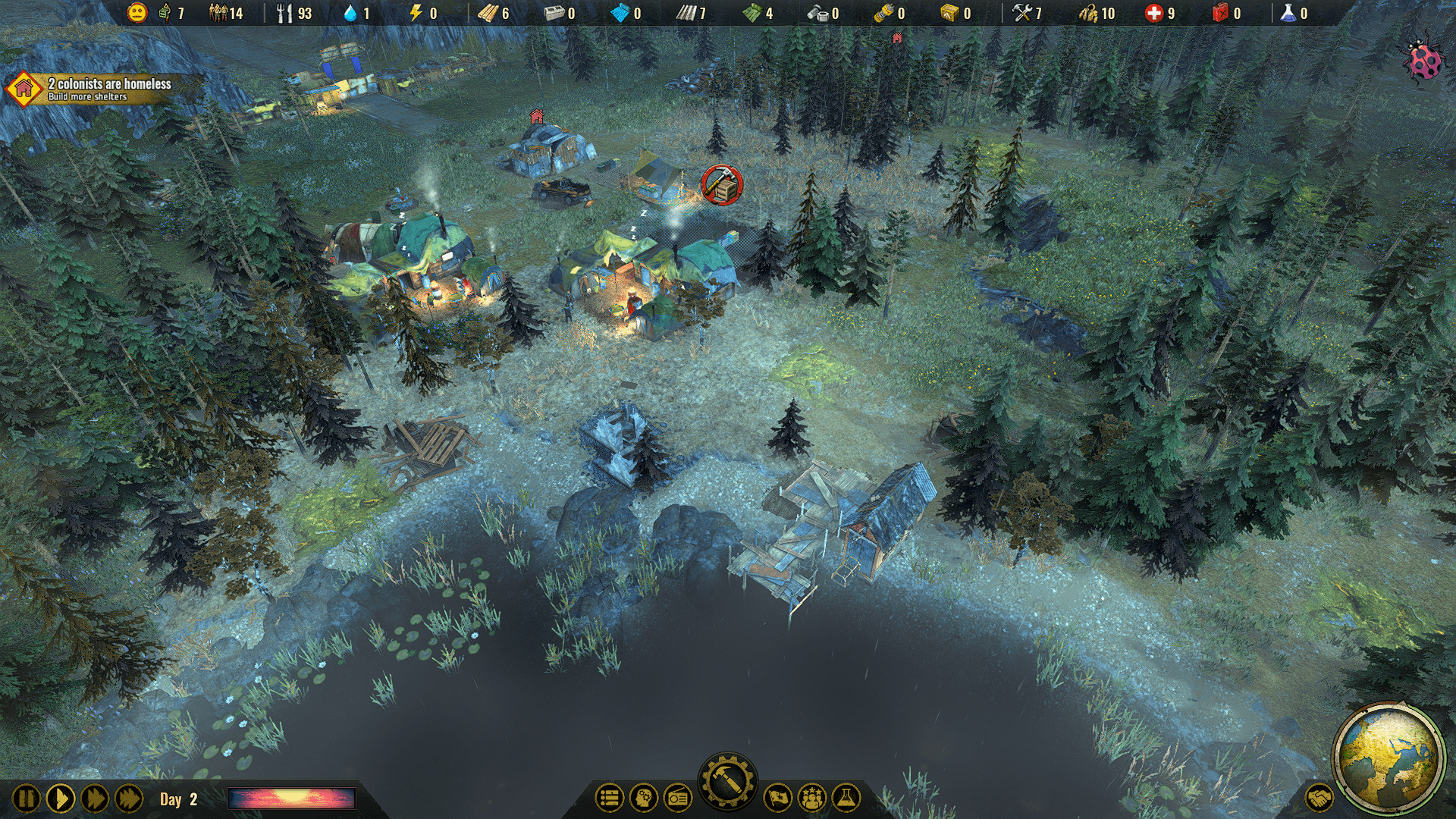
Setting up a colony in Surviving the Aftermath is fairly straightforward. In the beginning, you will have access to a few buildings that let you harvest resources from the map. Food stockpiles let you forage for berries, resource stockpiles will collect planks and concrete and scrappers and recyclers will breakdown metal and plastic deposits. This is all handled via a process of setting work areas for buildings; circular regions you can expand or shrink to cover more or less resources. This is quite a nifty idea, letting you manually choose resources in certain areas or prioritise planks over concrete or vice versa for the resource stockpiles. There are also environmental hazards to consider as the map will be covered with toxic deposits of nuclear fallout. If your gatherers have to traipse past too many they will become irradiated and require treatment at your scrappy medical facilities.
Radiation sickness is just one of several conditions that can afflict your colonists. Infections and injuries are a fact of life in the post-apocalypse and the spectre of starvation and homelessness are ever-present. At its core, the game breaks down to a fairly simple loop. To build the facilities you need and craft the tools and clothing that will help you survive, you need resources. To get resources you need people. Those people need more resources though. Which needs more people.

Thankfully the game periodically throws groups of prospective new community members at your colony gates. Each will arrive with a number of employable adults, a number of useless, parasitic children (there is no space for compassion in the aftermath) and some amount of resources that can range from the uninspiring (corn, clothing, tools) to the essential (antibiotics, components, fuel). The choice is yours as to whether to make space for them or whether to turn them away. Currently, there is no downside to refusing to take in colonists, although, as with everything in the game, that could change. Colony happiness, in general, seems to be somewhat underdeveloped at the moment. Whether your community members are well-rested, well-fed and entertained or tired, starving and tense seems to make very little difference to anything.
In the early days, you will find yourselves consistently working to build more facilities to use new people and more houses to keep them away from the dangers of exposure. The choice over how fast to expand, and how far, is entirely up to you though; if you refuse to take new colonists it will be fairly easy to build a neat, compact colony that sustains while there are resources on the map. However, at some point, those resources will run out and you will have two main routes to keep them going.
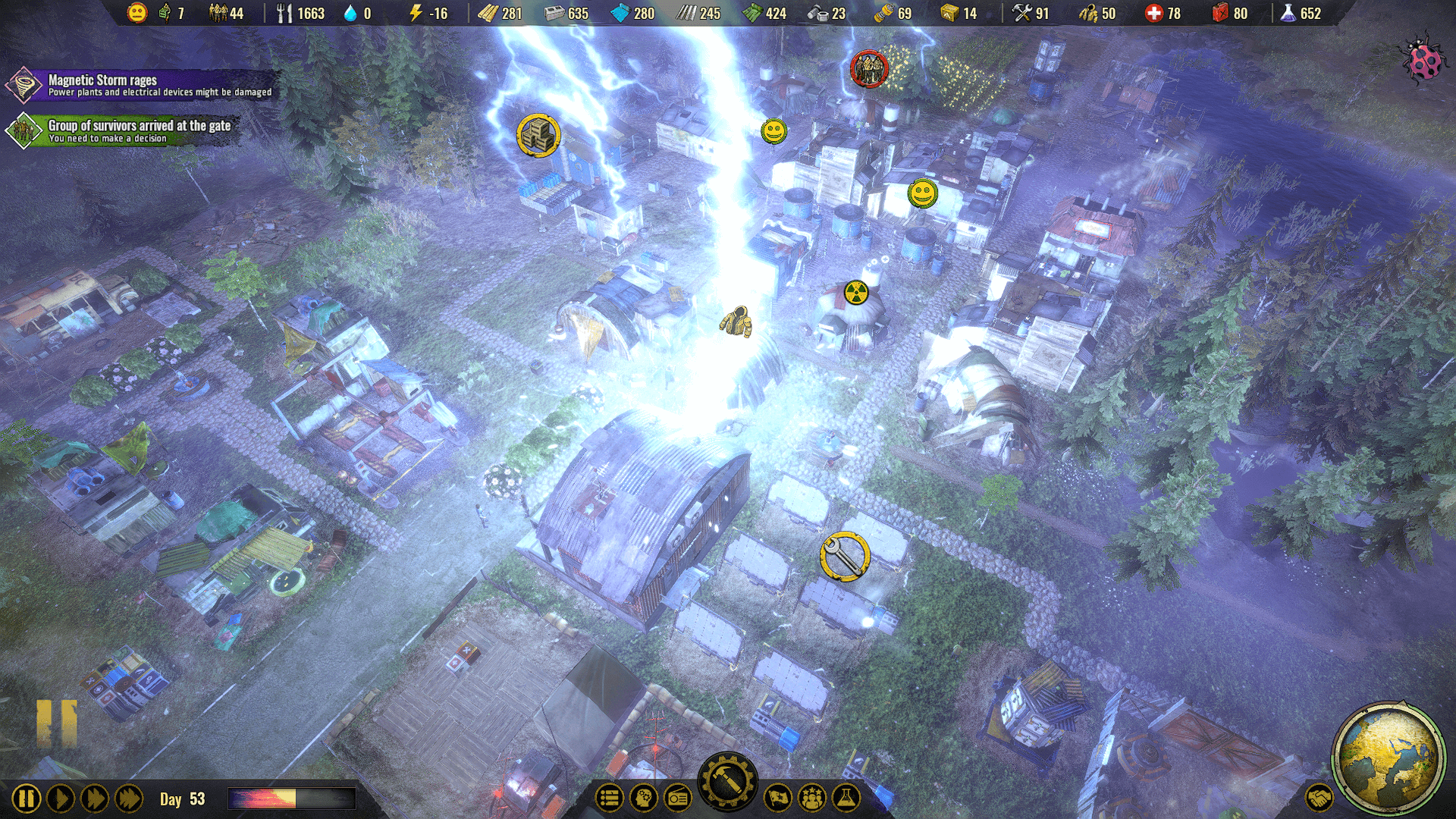
The first is technology. As in most games of this type, there is a tech tree of advances for you to research. Many of these are essential to sustainability; you will need to research sawmills when your plank deposits run out and deep mining to access underground deposits of concrete, metal and plastic. All of these will require people to run them, sometimes quite a lot, so you’re going to have to open those gates at some point. Research in Surviving the Aftermath works a little differently to most games though; you will actually need to spend research points to unlock these technologies and, try as you might, nothing you can do in your colony will give you any.
Collecting these research points is the sole preserve of specialists. These unique characters will show up as part of the groups of prospective colonists that come to your gate and are one of the biggest incentives to letting the scruffs in. Specialists can be sent away from the colony to the world map where they can explore and scavenge for valuable items and, crucially, deposits of research points. In the game, this is handled as a turn-based mini-game. Twice a day your specialists will receive an allotment of action points. You can spend these moving about the world map, scavenging from sites (some hazardous, potentially injuring your specialist) exploring new hexes or fighting bandits.

Yes, bandits. Many of these deposits will be guarded by Mad Max-style raiders. In its current form, combat in Surviving the Aftermath is fairly straightforward. You tell your specialist to attack, they do an amount of damage based on their attack stat (some are better than others) and, if the bandit is still alive, they take an amount of damage back. This continues until the bandit is dead or you give it up as a bad job and send the specialist back to the colony to heal. I can’t say I’m a fan of this system as it stands, it feels perfunctory and uninspired, however, it also feels like a placeholder. It wouldn’t surprise me at all to see combat revamped and spiced up in one of the monthly updates.
One way or another, you will have to send your specialists back to the colony sooner or later; either due to injury or because they are carrying valuable resources your colonists need to survive. Using your specialists efficiently is one of the challenges of Surviving the Aftermath but it also quickly becomes one of the most tedious. Even with the addition of vehicles and outposts to make navigating the world map less onerous, the process soon gets tiresome, particularly once you reach a point where you don’t particularly need much that the world map can offer.
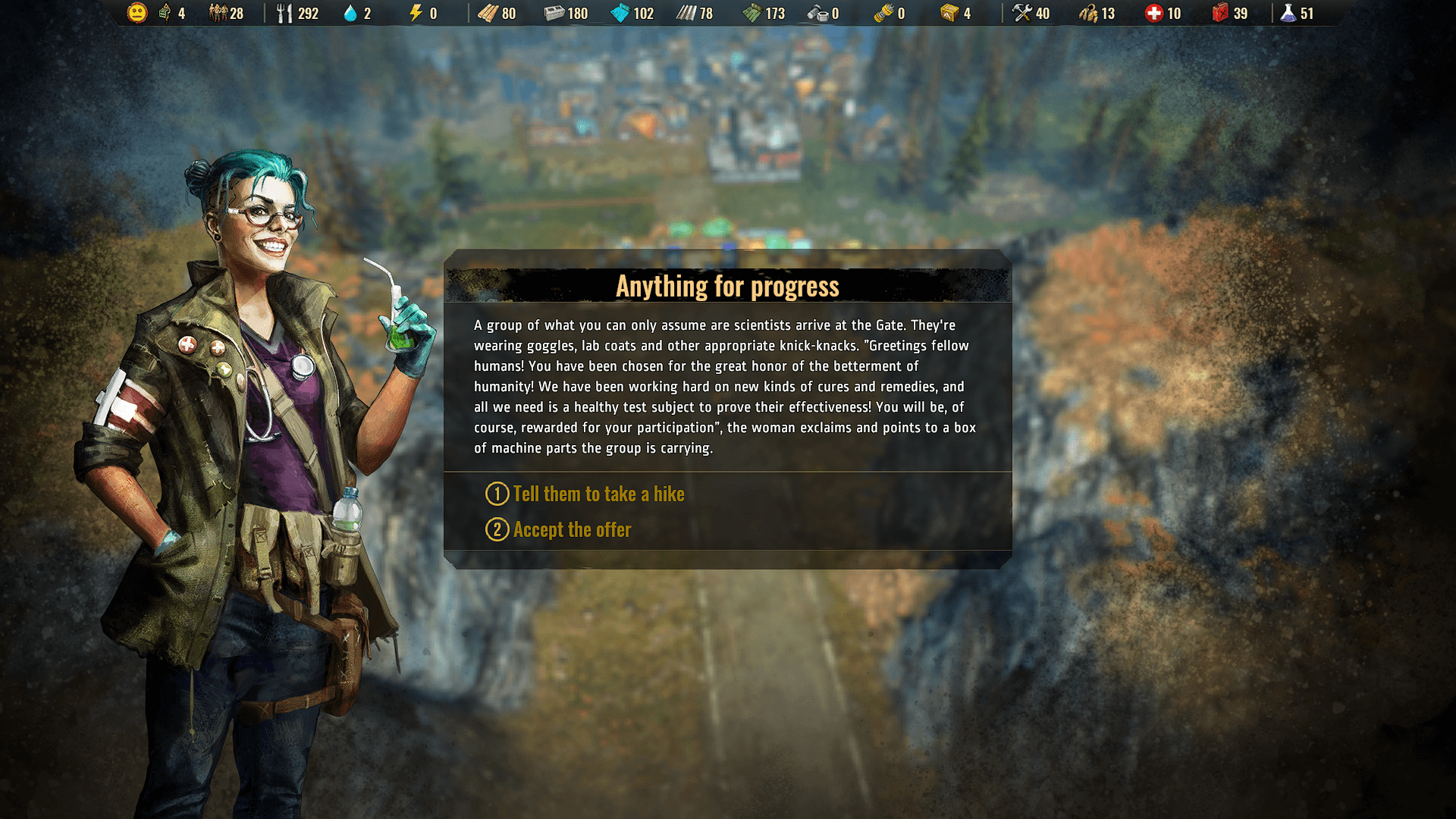
The truth of the matter is that even before you reach the point of self-sustainability where you can make everything you need, you don’t need much from the specialists. Surviving the Aftermath is just pretty easy. I played the game on normal difficulty (there is a really nice, narrative-inflected way of selecting your difficulty at the start of the game that I won’t spoil) and never felt even slightly challenged. None of my colonists died or even came close to it, even with the crises the game periodically throws at you. These range from toxic storms that will irradiate your colonists and kill your crops to pandemics to magnetic storms that damage all of your buildings. It doesn’t take much more than a bit of common sense to get through these events though; make sure you have a few standby medical tents and harvest your fields before the fallout hits.
Adjusting the difficulty up doesn’t seem to do much to address this either. I played for a few hours on maximum difficulty and watched an entire series from YouTuber xwynns where he played on the same setting and even refused to turn away any groups of survivors. There were a few deaths but nothing that affected the colony too adversely. Most of his colony were homeless, occasionally starving and lacking tools and clothes to no major discernible negative effect. Again, like with the combat system, I don’t intend for this to be a denunciation of what is, after all, a game in the process of being built and balanced. These factors have to be considered in making a call on whether Surviving the Aftermath is worth jumping into now though.
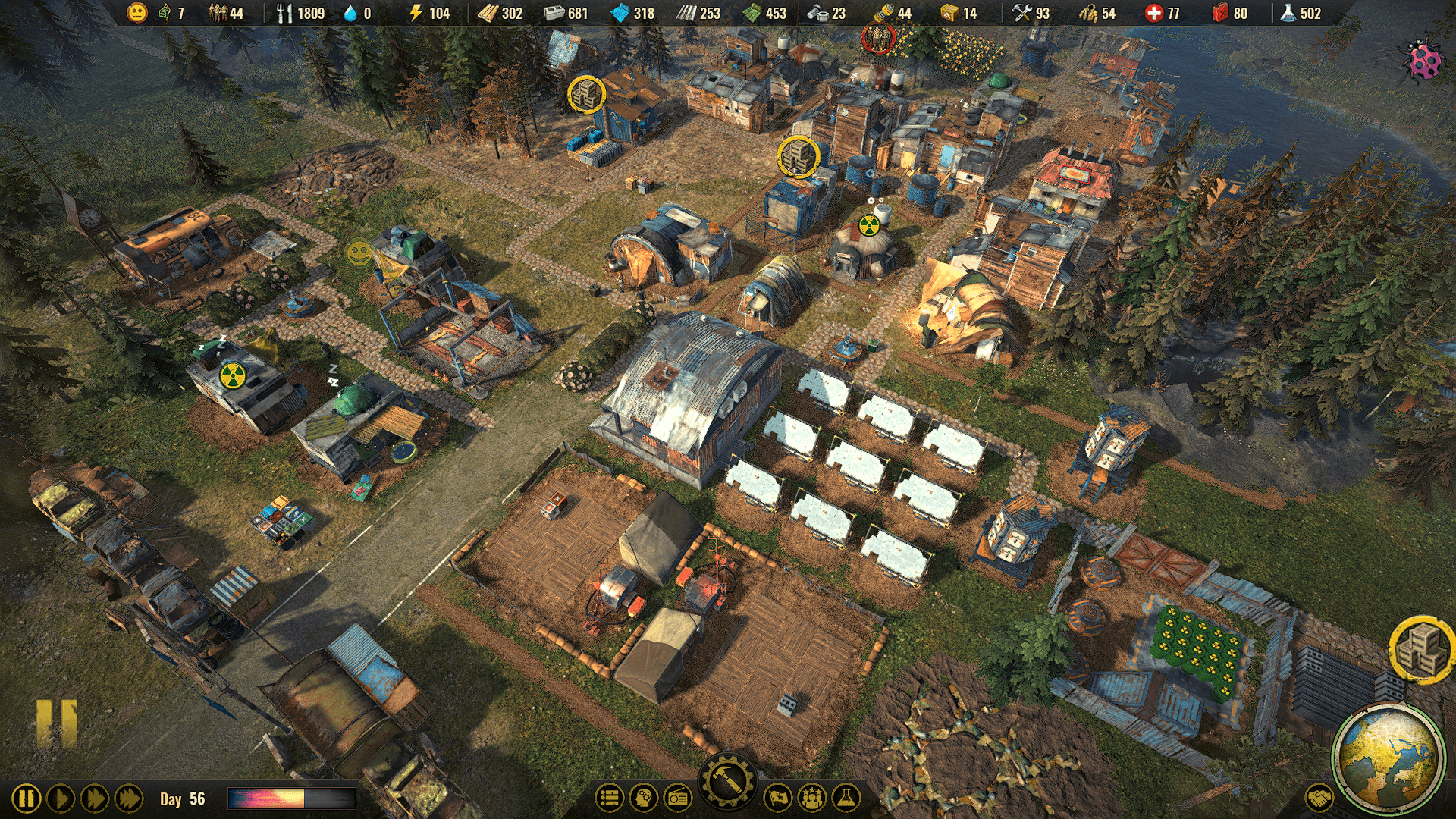
I feel very comfortable in saying that there is the potential for a very enjoyable survival sim here. For all its promise I think I have to recommend only keeping an eye on the game until it’s released though. Surviving the Aftermath as it currently stands is diverting but quickly runs out of steam after a few hours of gameplay. The exception might be if you’re in the market for a nice, gently settlement-builder. Hopefully from the screenshots in this review, you can see that there is a wealth of decorative items in the game and it can be very satisfying to make the prettiest post-apocalyptic colony you can. For everyone else though, right now, it could go either way. It could become a staple of the survival sim genre or just a curiosity and mild diversion. Watch this space though because all the elements are in place for success if it keeps moving in the right direction.
Surviving the Aftermath is available now on PC on the Epic Games Store with a launch on Steam and for PS4 and Xbox One coming on the game’s full release in late 2020.